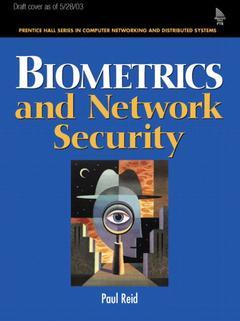Biometrics and network security
Langue : Anglais
Auteur : REID Paul

A guide to integrating biometrics in the process of network security. Covers: finger, iris, retina, voice and fac biometrics. Emphasis on how to quantify the strength of a particular biometric. Complete with guidelines for deployment in a large enterprise, one of author's clients is Citibank and they are about to start using biometrics in their network authentication system around the world.
Foreword. Preface. SECTION I: INTRODUCTION AND BACKGROUND. 1. Introduction. What Makes This Book Different? The Structure of This Book. Everything You Need to Know about Biometrics to Read the First Three Chapters. Who Should Read This Book? Conclusion. 2. Authentication Technologies. Something You Know. Something You Have. Something You Are. The Need for Strong Authentication. The Role of Strong Authentication with Single Sign on (SSO). Biometric Technologies: An Intelligent Solution. Conclusion. 3. Protecting Privacy with Biometrics and Policy. Employer's Right to Privacy. Employee's Right to Privacy. Conclusion. SECTION II: BIOMETRIC TECHNOLOGIES. 4. Biometric Technologies. User Interaction with Biometric Technology. What Makes a Good Biometric? What Makes a Good Biometric for Network Security? Conclusion. 5. Finger Biometric Technologies. General Description of Fingerprints. How is the Finger Imaged? What Types of Algorithms Are Used for Their Interpretation? How Can This Biometric Be Spoofed? Conclusion. 6. Face Biometric Technologies. General Description of Face Biometrics. How Is the Face Imaged? What Types of Algorithms Are Used for Their Interpretation? How Can This Biometric Be Spoofed? Conclusion. 7. Voice Biometric Technologies. General Description of Voice Biometrics. How is the Voice Captured? What Types of Algorithms Are Used for Their Interpretation? Which Algorithm Is Best? Recommended Voice Algorithm. How Can This Biometric Be Spoofed? Conclusion. 8. Iris Biometric Technology. General Description of Iris Biometrics. How Is the Iris Captured? Description of the Iris Algorithm. How Can Iris Biometric Be Spoofed? Conclusion. SECTION III: IMPLEMENTING BIOMETRICS FOR NETWORK SECURITY. 9. Recommended Biometric for Network Security. Finger Biometrics. Face Biometrics. Voice Biometrics. Iris Biometrics. The Choice of a Biometric for Network Access. Conclusion. 10. An Introduction to Statistical Measures of Biometrics. False Acceptance Rate (FAR). False Rejection Rate (FRR). Failure to Enroll (FTE). Equal Error Rate (EER). What Measure Is Most Important. Conclusion. 11. The Biometric Transaction. The Securing and Trusting of a Biometric Transaction. Matching Location. Conclusion. Section IV: FUTURE AND CONCLUSIONS. 12. Preparing for the Proof of Concept and Vendor Selection. Is This Project Being Driven By Corporate IT or a Business Need. Define the Business Need or Objective. Designate the Internal Sponsor of the Project. Define the Group of Stake Holders. Define a Set of Clear Goals and Success Criteria for the Project. Form and Charter the Proof of Concept Group. Based Upon Goals and Success Criteria, Invite Only a Few Vendors to Pilot. Set the Time Lines for the POC and Ensure That the Implementation Activities are Done Within the Scope of the Proof of Concept. Deploy the Proof of Concept. Monitor and Evaluate The POC. Wrap Up the Proof of Concept. Conclusion. 13. Preparing for the Pilot Deployment. Define the Group of Stake Holders. Put in Place a Project Management Team That Can See the Solution through to Roll Out. Form and Charter the Pilot Group. Develop Policy Documents. Have Daily Reports Summarized Weekly and Sent Up and Out. Address and Track Problems and Solutions as They Happen. Put A Training Plan in Place. Prepare the Audit and Analysis Reports of What Is Being Done. Get an Automated Install Built And Tested. Roll Out the Software and Hardware in a Manner That Makes Sense. Provide Mechanisms for Feed Back. After Initial Pilot Roll Out, and the Speed Bumps Are Over Come, Get the Executives Involved. Start Addressing Issues of Scalability and Manageability for A Roll Out. Near the End of the Pilot, Start Discussions on the Next Steps. Wrap Up the Pilot. Make The Go/No Go Decision. Build A Transition Book To Move the Project from Research and Engineering and Hand It Off to Production. Conclusion. 14. Preparing for the Roll Out. Why is This Chapter So Short? Conclusion. 15. Future of Biometric Authentication. Will Biometrics Be Integrated Every Where? What Other Biometric Measures Will Exist? A Futuristic Example: New Form of Caller ID . Conclusion. Bibliography. Glossary. Index.
Date de parution : 01-2004
Ouvrage de 320 p.
23.5x17.8 cm
Thèmes de Biometrics and network security :
© 2024 LAVOISIER S.A.S.



